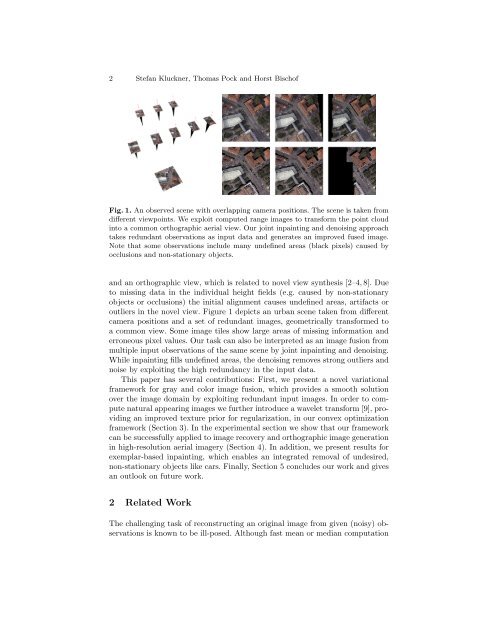Exploiting Redundancy for Aerial Image Fusion using Convex ...
Exploiting Redundancy for Aerial Image Fusion using Convex ...
Exploiting Redundancy for Aerial Image Fusion using Convex ...
Create successful ePaper yourself
Turn your PDF publications into a flip-book with our unique Google optimized e-Paper software.
2 Stefan Kluckner, Thomas Pock and Horst Bischof<br />
Fig. 1. An observed scene with overlapping camera positions. The scene is taken from<br />
different viewpoints. We exploit computed range images to trans<strong>for</strong>m the point cloud<br />
into a common orthographic aerial view. Our joint inpainting and denoising approach<br />
takes redundant observations as input data and generates an improved fused image.<br />
Note that some observations include many undefined areas (black pixels) caused by<br />
occlusions and non-stationary objects.<br />
and an orthographic view, which is related to novel view synthesis [2–4, 8]. Due<br />
to missing data in the individual height fields (e.g. caused by non-stationary<br />
objects or occlusions) the initial alignment causes undefined areas, artifacts or<br />
outliers in the novel view. Figure 1 depicts an urban scene taken from different<br />
camera positions and a set of redundant images, geometrically trans<strong>for</strong>med to<br />
a common view. Some image tiles show large areas of missing in<strong>for</strong>mation and<br />
erroneous pixel values. Our task can also be interpreted as an image fusion from<br />
multiple input observations of the same scene by joint inpainting and denoising.<br />
While inpainting fills undefined areas, the denoising removes strong outliers and<br />
noise by exploiting the high redundancy in the input data.<br />
This paper has several contributions: First, we present a novel variational<br />
framework <strong>for</strong> gray and color image fusion, which provides a smooth solution<br />
over the image domain by exploiting redundant input images. In order to compute<br />
natural appearing images we further introduce a wavelet trans<strong>for</strong>m [9], providing<br />
an improved texture prior <strong>for</strong> regularization, in our convex optimization<br />
framework (Section 3). In the experimental section we show that our framework<br />
can be successfully applied to image recovery and orthographic image generation<br />
in high-resolution aerial imagery (Section 4). In addition, we present results <strong>for</strong><br />
exemplar-based inpainting, which enables an integrated removal of undesired,<br />
non-stationary objects like cars. Finally, Section 5 concludes our work and gives<br />
an outlook on future work.<br />
2 Related Work<br />
The challenging task of reconstructing an original image from given (noisy) observations<br />
is known to be ill-posed. Although fast mean or median computation















